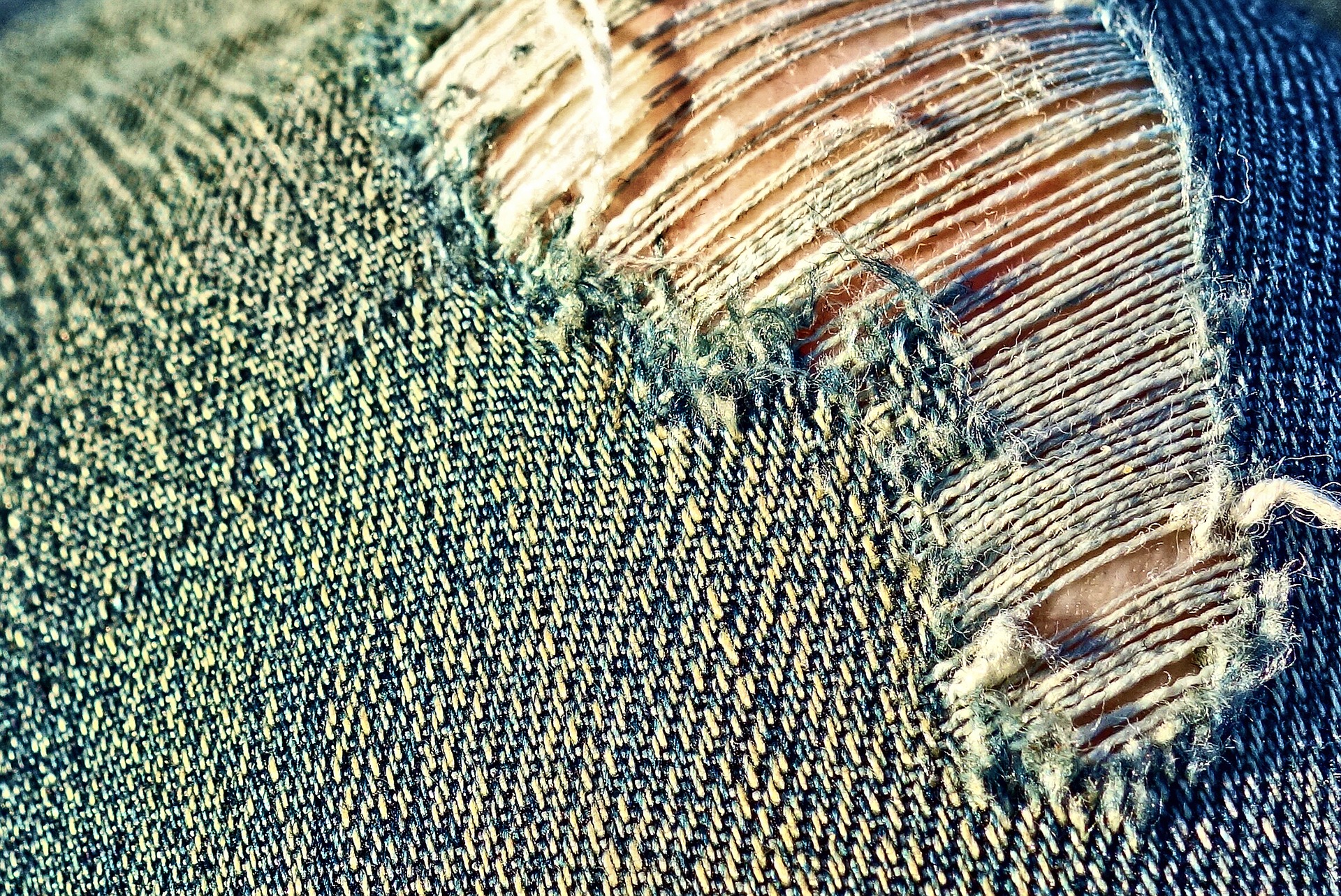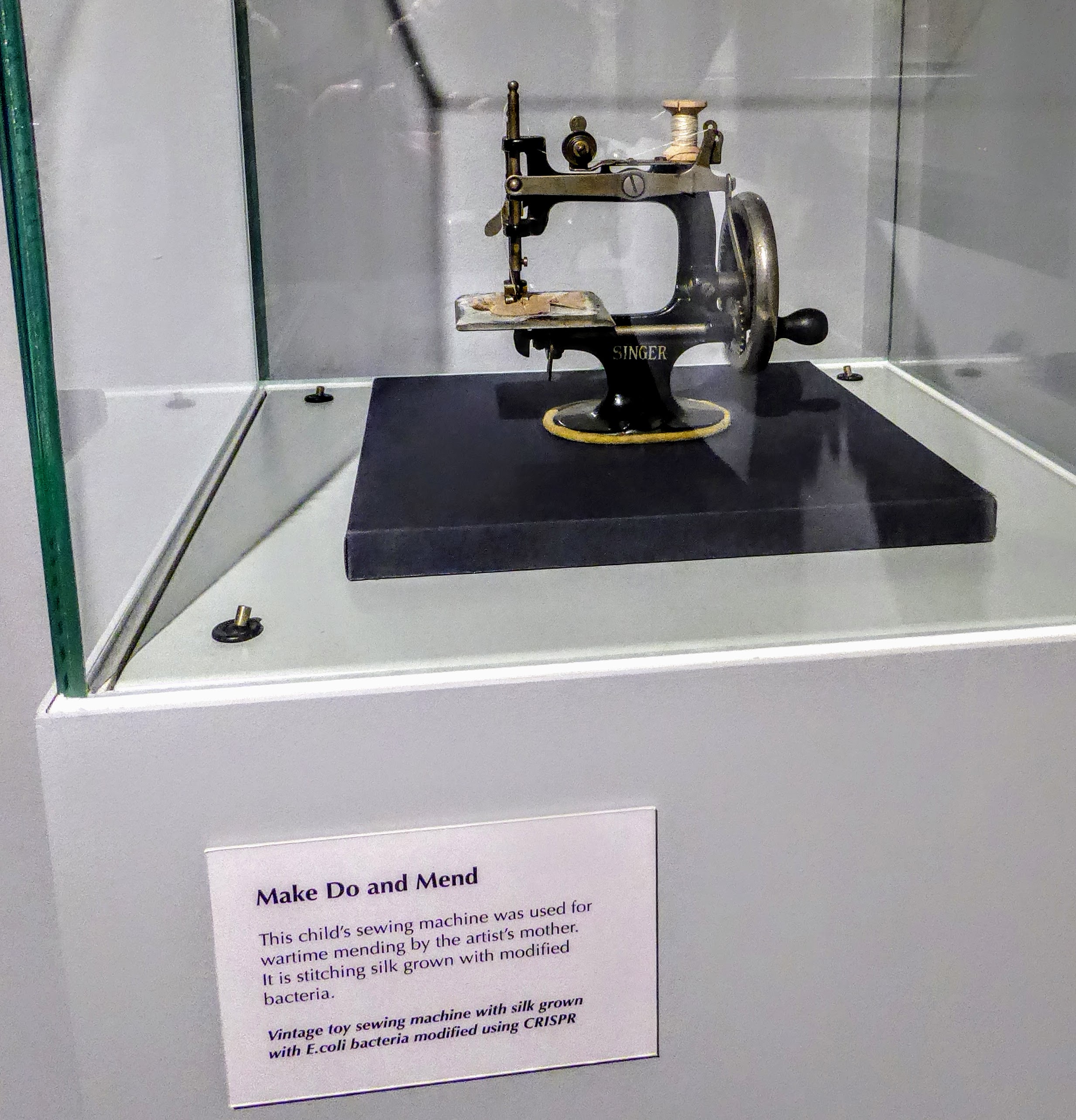
December 1, 2017, by Brigitte Nerlich
Genome editing: Invisible mending
Last week I had a few days in Oxford to visit old haunts, such as the Ashmolean, the Museum of Natural History and the Pitt Rivers Museum. I also went to a little exhibition in the basement of the Museum of the History of Science. The exhibition by Anna Dumitriu was entitled BioArt and Bacteria. It dealt with two topics I am really interested in, namely synthetic biology/genome editing and antibiotics.
On the way down to Oxford I had read a few articles about a new advance in genome editing, namely a first attempt at genome editing inside the human body. This had been reported in newspapers and on social media on 15th November.
When walking through the BioArt exhibition, my eye was drawn to one exhibit, namely that of a toy sewing machine (see photo at the end of the post). This central piece of the exhibition was entitled ‘Make do and mend’.
This reminded me of a phrase I had read in some of the ‘gene editing in the human body’ articles, namely that of ‘invisible mending’. Dr Sandy Macrae, president of Sangamo Therpeutic, the California company which is testing the new genome editing technique, had used this metaphor in an interview. She said: “We cut your DNA, open it up, insert a gene, stitch it back up. Invisible mending…It becomes part of your DNA and is there for the rest of your life.”
She had created the invisible mending metaphor in the following context: “A treatment where genome editing takes place inside the patient’s body is being trialled in California to combat the metabolic disorder Hunter syndrome. The patient, Brian Madeux, was given an infusion containing billions of DNA copies of the gene that codes for an enzyme he lacks, as well as a type of genome editing machinery called zinc finger nucleases (ZFNs). Previous genome editing treatments have involved altering extracted blood or skin cells in the lab, and then returning the treated cells to the patient.”
Almost all the news outlets reporting on the new genome editing advance repeated the ‘invisible mending’ quote. As a metaphor hunter, I picked up that metaphor and pinned it down as a collectible. I also asked myself whether anybody had used it before and how it fitted in with similar metaphors of repairing, stitching, sewing and tinkering. (By the way, ‘tinkering’ as a molecular metaphor, is 40 years old; François Jacob coined it in 1977).
Stitching metaphors in synbio and gene editing
I first became aware of ‘small’ metaphors, such as ‘stitching’ or ‘tinkering’, when researching the metaphorical framing of synthetic biology (Hellsten and Nerlich 2011). I was surprised to find such metaphors used alongside ‘grander’ metaphors, such as ‘deciphering the book of life’, ‘revealing the building blocks of life’ and such like. When digging a bit deeper, I discovered something that will not be surprising to working scientists, namely that such metaphors have been around for quite some time, probably at least since the time of recombinant DNA in the 1970s.
As one blog post says: “By the mid 1970s, scientists had discovered DNA-snipping molecular scissors known as restriction enzymes, and DNA-stitching enzymes called ligases. It became possible to cut and splice the genetic code, stitching components from different organisms to create recombinant DNA.”
Around 2008 the stitching metaphor was revived in the context of early advances in synthetic biology, especially the man-made creation of the genome for the pathogenic bacterium Mycoplasma genitalium by Hamilton Smith and his colleagues at the J. Craig Venter Institute in Rockville, Maryland. Philip Ball announced this breakthrough in Nature under the title “Genome stitched together by hand”, and the caption underneath the image accompanying this article said, humorously: “Stitched up: more than 500,000 bits of DNA have been assembled in the lab, creating the instructions for a bacterium.”
The stitching metaphor was also used in 2010, when Craig Venter announced the creation of a first synthetic cell, and in 2014, when xeno DNA was created. That’s probably only the tip of the stitching iceberg.
More recently, we have had another surge in such metaphors, as scientists thought that they could now do this snipping and stitching more easily and precisely using a new technique called CRISPR Cas9.
However, more recently still, some doubts have been raised about this promise of precision, for example in an article published in Nature: “The Cas9 enzyme breaks DNA strands, and cells can attempt to repair the damage by haphazardly stitching the genome together, often resulting in missing or extra DNA letters.” Scientists hope that an even newer technique, namely base editing, will revive the old promise of precision and overcome the haphazard stitching problem.
Invisible mending
Let us now turn our attention to ‘invisible mending’. As far as I can make out, this metaphor has not been used in genetic/genomic discourse before 15 November 2017. It’s a new creation by Sandy Macrae, but it is, of course, embedded in older metaphors of stitching and repairing. Let’s just recall what she said: “We cut your DNA, open it up, insert a gene, stitch it back up. Invisible mending…It becomes part of your DNA and is there for the rest of your life.”
The metaphor was first made public in an Associated Press exclusive by Marilynn Marchione on 15 November at 10:02 pm (according to the news database Lexis Nexis). After that it was picked up by numerous English speaking articles published in traditional and social media (about 30). Macrae’s quote was used mostly after a paragraph saying: “This time, the gene tinkering is happening in a precise way inside the body. It’s like sending a mini surgeon along to place the new gene in exactly the right location. That also means there’s no going back, no way to erase any mistakes the editing might cause.” The miniature surgeon metaphor has, of course, its own long history, reaching back to Richard Feynman’s 1959 speech “There’s plenty of room at the bottom”.
Some articles led up to the invisible mending quote in a different way, focusing on the type of ‘scissor’ involved in this intervention, scissors that are a bit more old-fashioned than CRISPR Cas9: “Through an IV, Mr Madeux received billions of copies of a corrective gene and genetic tools to cut his DNA in a precise spot. They travel to the liver, where cells use the instructions to make molecular scissors – called zinc finger nucleases – and prepare the corrective gene. The fingers cut the DNA, allowing the new gene to slip in. The new gene then directs the cell to make the enzyme the patient lacked.”
The role of the mending metaphor in the BioArt exhibition
So what is invisible mending? Wikipedia tells us the following: “Invisible mending is a sophisticated weaving method consisting in rebuilding the fabric of a damaged garment or upholstery, following damage caused for example by a snag, burn, or accidental scissor cut.”
In our case neither sewing needles nor a sewing machine were used, but a “GPS like recognition system” (see video at 1.13; a metaphor that I briefly mentioned in my blog post on public uses of metaphors relating to genome editing) combined with something called (metaphorically) ‘zink finger nucleases’ (the ‘scissors’)
All this is literally and metaphorically rather complex, something that is reflected in the BioArt exhibition (click on the link for pictures and video), to which I will now briefly turn. At the exhibition I saw what one might call many different patchworks or quilts of MRSA or TB, as well as a dress onto which the letters G, T, C, and A were projected and much more. All the exhibits (and all the metaphors used) together told a story, which, to be frivolous, the viewer had to ‘stitch’ together in order to make sense of both science and its social and ethical implications. As one reviewer of the show, Annick Bureaud, said (and as I can’t say it any better, I’ll quote her at length):
“Anna Dumitriu is using craft techniques, often connoted as feminine, in her artworks while working with the latest biotechnologies to address crucial contemporary issues […] Each technique acts as a metaphor to the other to deploy the embodied enmeshed stories. In this respect, the homologous recombination technique can be compared to patching and the whole process of gene editing to craft with its meticulous steps and endless pipetting and ‘cooking’ procedures. Moreover, the clichés of ‘male-science’ and ‘female-craft’ are put upside down: science is craft.”
“The mending metaphor is even more powerful and the sewing machine the real key element of the piece for bringing to the forefront the ethical issues that the work carries: it is a toy which is the exact replica of the real machine. Are we like kids playing with matches when thinking or ‘repairing’ faulty genomes or our own past medical and scientific mistakes?”
These are good questions to ask around the fast accelerating genome editing project, which some frame as scientists playing God, while others may see it as scientists just playing… What really happens probably lies somewhere in between.
Image: Mending jeans (got it!?) (from Pixabay)
Previous Post
Climate alarmism and climate realismNo comments yet, fill out a comment to be the first

Leave a Reply